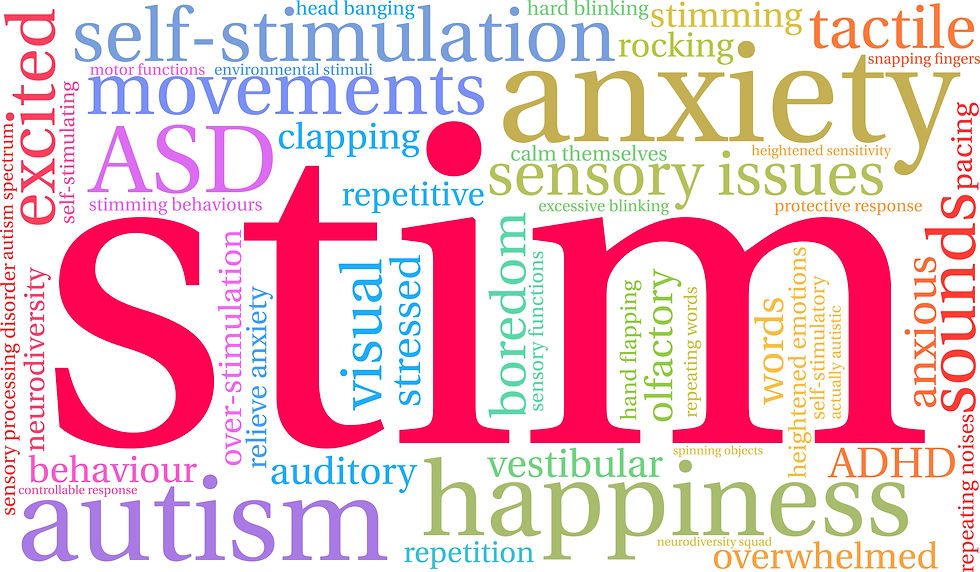Understanding the Importance of Stimming for Individuals with Autism
- LaKeshia Y. Wells, M.Psych, BCBA, LBA
- Mar 26, 2024
- 4 min read
What is stimming?
Stimming, short for self-stimulatory behavior, is a term used to describe the repetitive movements, vocal sounds, or intense focus on specific objects often exhibited by individuals with autism. This behavior serves a crucial purpose for individuals with autism, providing them with sensory input and a means of self-regulation. Stimming can manifest in various ways, such as hand flapping, rocking back and forth, spinning, tapping, or even finger flicking. While stimming is commonly associated with autism, it is important to recognize that not all individuals who stim have autism, and not all individuals with autism engage in stimming behaviors.
Types of stimming behaviors
Stimming behaviors can vary greatly from person to person, and each individual may have their unique preferences and patterns. Some common types of stimming behaviors include:
Physical movements
These can include hand flapping, spinning, rocking, jumping, pacing, or repetitive body movements. These movements often provide individuals with sensory input and help them regulate their sensory experiences.
Vocal sounds
Many individuals with autism engage in vocal stimming, which involves making repetitive sounds or noises. This can include humming, repetitive speech, echolalia (repeating words or phrases), or making unique vocalizations. Vocal stimming allows individuals to express themselves and release tension or stress.

Object-focused stimming
Some individuals with autism may become intensely focused on specific objects or items. They may engage in repetitive behaviors such as spinning objects, lining up toys, or flipping switches. This type of stimming provides individuals with a sense of control and familiarity in their environment.
It is important to remember that stimming behaviors are not inherently negative or harmful. They are a natural and adaptive way for individuals with autism to interact with their surroundings and manage their sensory experiences.
Why do people with autism stim?
The sensory aspect of stimming
One of the primary reasons individuals with autism engage in stimming is to manage overwhelming sensory experiences. People with autism often have differences in sensory processing, meaning they may be hypersensitive or hyposensitive to certain stimuli. Stimming allows them to regulate their sensory input, either by seeking additional sensory stimulation or by blocking out excessive sensory information.
For example, an individual who is hypersensitive to noise may engage in hand flapping or vocal stimming as a way to distract themselves from the overwhelming sounds around them. Similarly, someone who is hyposensitive to touch may engage in repetitive touching or rubbing of objects to seek additional sensory input and feel more grounded.
Emotional regulation and self-soothing
Stimming also plays a crucial role in emotional regulation for individuals with autism. It serves as a means of self-soothing and helps them cope with stress, anxiety, or other intense emotions. Engaging in stimming behaviors allows individuals to create a sense of predictability and control in their environment, which can be particularly beneficial in overwhelming or unpredictable situations.

By stimming, individuals with autism are able to calm themselves and regulate their emotions, enabling them to better navigate social interactions and daily activities. It is important to recognize that stimming is not a sign of immaturity or a lack of emotional expression; rather, it is a unique and effective way for individuals with autism to manage their emotions and maintain a sense of stability.
Communication and expression through stimming
Stimming can also serve as a form of communication and self-expression for individuals with autism. While stimming behaviors may appear repetitive or nonsensical to outsiders, they often hold personal significance and meaning for the individual engaging in them. Stimming can be a way for individuals with autism to communicate their needs, preferences, or emotions when verbal communication may be challenging.
For example, a person with autism may engage in hand flapping when they are excited or happy, or they may rock back and forth when they are feeling overwhelmed or anxious. By recognizing and understanding these stimming behaviors, we can gain insights into the emotional state and preferences of individuals with autism, allowing for more effective communication and support.
Misconceptions and stigma around stimming
Despite its importance and value for individuals with autism, stimming is often misunderstood and stigmatized in society. Many people mistakenly view stimming as disruptive, attention-seeking, or indicative of a lack of intelligence. It is crucial to challenge these misconceptions and promote acceptance and understanding of stimming. Stimming is not a behavior that needs to be eliminated or suppressed; instead, it should be embraced as an integral part of an individual's identity and neurological makeup.
Strategies for managing stimming behaviors
While stimming is an important and beneficial behavior for individuals with autism, there may be instances where managing stimming behaviors becomes necessary. Here are some strategies that can be employed:
Identify triggers
Observe and identify any specific triggers that may lead to increased stimming behaviors. This can help in finding ways to minimize or modify the triggering situations.
Redirect attention
Offer alternative activities or outlets that provide sensory input or serve as a distraction from stimming behaviors. This can include engaging in physical exercise, providing tactile or visual stimulation, or encouraging creative expression.

Develop self-regulation techniques
Work with individuals to develop self-regulation techniques that can help them manage their sensory needs and emotions. This can include deep breathing exercises, mindfulness practices, or engaging in calming activities.
Establish routines and predictability
Create a structured and predictable environment that helps individuals feel secure and reduces anxiety. Establishing clear routines and schedules can provide individuals with a sense of stability and control.
Seek professional guidance
If stimming behaviors become disruptive or interfere with daily functioning, it may be beneficial to seek guidance from professionals specializing in autism or behavior management. They can provide personalized strategies and support.
Conclusion
Stimming is a natural and necessary behavior for individuals with autism. It serves as a means of sensory regulation, emotional expression, and self-soothing. By understanding and accepting stimming, we can create a more inclusive and supportive environment for individuals with autism. It is essential to challenge misconceptions and stigma around stimming, recognizing it as a unique aspect of neurodiversity. By promoting acceptance, providing support, and employing strategies tailored to individual needs, we can ensure that individuals who stim feel valued, respected, and empowered in their journey.






Comments